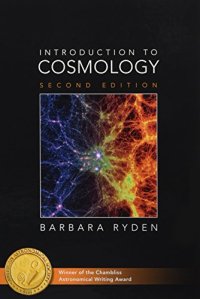
Ebook: Introduction to Cosmology
Author: Barbara Ryden
- Genre: Physics // Astronomy: Astrophysics
- Tags: Cosmology, Astronomy & Space Science, Science & Math, Science & Mathematics, Agriculture, Astronomy & Astrophysics, Biology & Life Sciences, Chemistry, Earth Sciences, Environmental Studies, Mathematics, Mechanics, Physics, New Used & Rental Textbooks, Specialty Boutique
- Year: 2016
- Publisher: Cambridge University Press
- Edition: 2
- Language: English
- pdf
Attempting to cover the study of the entire universe in a single volume may
seem like a megalomaniac’s dream. The universe, after all, is richly textured,
with structures on a vast range of scales; planets orbit stars, stars are collected
into galaxies, galaxies are gravitationally bound into clusters, and even
clusters of galaxies are found within larger superclusters. Given the
complexity of the universe, the only way to condense its history into a single
book is by a process of ruthless simplification. For much of this book,
therefore, we will be considering the properties of an idealized, perfectly
smooth, model universe. Only near the end of the book will we consider how
relatively small objects, such as galaxies, clusters, and superclusters, are
formed as the universe evolves. It is amusing to note in this context that the
words cosmology and cosmetology come from the same Greek root: the word
kosmos, meaning harmony or order. Just as cosmetologists try to make a
human face more harmonious by smoothing over small blemishes such as
pimples and wrinkles, cosmologists sometimes must smooth over small
“blemishes” such as galaxies.
A science that regards entire galaxies as being small objects might seem,
at first glance, very remote from the concerns of humanity. Nevertheless,
cosmology deals with questions that are fundamental to the human condition.
The questions that vex humanity are given in the title of a painting by Paul
Gauguin (Figure 1.1): “Where do we come from? What are we? Where are
we going?” Cosmology grapples with these questions by describing the past,
explaining the present, and predicting the future of the universe.
Cosmologists ask questions such as “What is the universe made of? Is it finite
or infinite in spatial extent? Did it have a beginning some time in the past?
Will it come to an end some time in the future?”
---
The second edition that you are reading now is updated with observational
and theoretical developments during the 14 years that have elapsed since the
first edition. It has been improved by many comments by readers. (My thanks
go to the eagle-eyed readers who caught the typographical errors that snuck
into the first edition.) The second edition also contains an extended
discussion of structure formation in the final two chapters. For a brief course
on cosmology, the first ten chapters can stand on their own.
Unfortunately, the National Bureau of Standards has not gotten around to
establishing a standard notation for cosmological equations. It seems that
every cosmology book has its own notation; this book is no exception. My
main motivation was to make the notation as clear as possible for the
cosmological novice.
Many of the illustrations in this book were adapted from figures in
published scientific papers; my thanks go to the authors of those papers for
granting permission to use their figures or to replot their hard-won data.
This second edition of Introduction to Cosmology is an exciting update of an award-winning textbook. It is aimed primarily at advanced undergraduate students in physics and astronomy, but is also useful as a supplementary text at higher levels. It explains modern cosmological concepts, such as dark energy, in the context of the Big Bang theory. Its clear, lucid writing style, with a wealth of useful everyday analogies, makes it exceptionally engaging. Emphasis is placed on the links between theoretical concepts of cosmology and the observable properties of the universe, building deeper physical insights in the reader. The second edition includes recent observational results, fuller descriptions of special and general relativity, expanded discussions of dark energy, and a new chapter on baryonic matter that makes up stars and galaxies. It is an ideal textbook for the era of precision cosmology in the accelerating universe.
This second edition of Introduction to Cosmology is an exciting update of an award-winning textbook. It is aimed primarily at advanced undergraduate students in physics and astronomy, but is also useful as a supplementary text at higher levels. It explains modern cosmological concepts, such as dark energy, in the context of the Big Bang theory. Its clear, lucid writing style, with a wealth of useful everyday analogies, makes it exceptionally engaging. Emphasis is placed on the links between theoretical concepts of cosmology and the observable properties of the universe, building deeper physical insights in the reader. The second edition includes recent observational results, fuller descriptions of special and general relativity, expanded discussions of dark energy, and a new chapter on baryonic matter that makes up stars and galaxies. It is an ideal textbook for the era of precision cosmology in the accelerating universe.
Download the book Introduction to Cosmology for free or read online
Continue reading on any device:

Last viewed books
Related books
{related-news}
Comments (0)